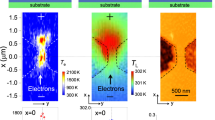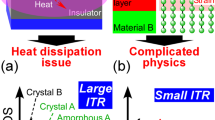Abstract
Managing energy dissipation is critical to the scaling of current microelectronics1,2,3 and to the development of novel devices that use quantum coherence to achieve enhanced functionality4. To this end, strategies are needed to tailor the electron–phonon interaction, which is the dominant mechanism for cooling non-equilibrium (‘hot’) carriers5,6. In experiments aimed at controlling the quantum state7,8,9,10,11, this interaction causes decoherence that fundamentally disrupts device operation12,13. Here, we show a contrasting behaviour, in which strong electron–phonon scattering can instead be used to generate a robust mode for electrical conduction in GaAs quantum point contacts, driven into extreme non-equilibrium by nanosecond voltage pulses. When the amplitude of these pulses is much larger than all other relevant energy scales, strong electron–phonon scattering induces an attraction between electrons in the quantum-point-contact channel, which leads to the spontaneous formation of a narrow current filament and to a renormalization of the electronic states responsible for transport. The lowest of these states coalesce to form a sub-band separated from all others by an energy gap larger than the source voltage. Evidence for this renormalization is provided by a suppression of heating-related signatures in the transient conductance, which becomes pinned near 2e2/h (e, electron charge; h, Planck constant) for a broad range of source and gate voltages. This collective non-equilibrium mode is observed over a wide range of temperature (4.2–300 K) and may provide an effective means to manage electron–phonon scattering in nanoscale devices.
This is a preview of subscription content, access via your institution
Access options
Subscribe to this journal
Receive 12 print issues and online access
$259.00 per year
only $21.58 per issue
Buy this article
- Purchase on Springer Link
- Instant access to full article PDF
Prices may be subject to local taxes which are calculated during checkout



Similar content being viewed by others
References
Chau, R., Doyle, B., Datta, S., Kavalieros, J. & Zhang, K. Integrated nanoelectronics for the future. Nature Mater. 6, 810–812 (2007).
Pop, E. Energy dissipation and transport in nanoscale devices. Nano. Res. 3, 147–169 (2010).
Chang, L. et al. Practical strategies for power-efficient computing technologies. Proc. IEEE 98, 215–236 (2010).
Awschalom, D. D., Bassett, L. C., Dzurak, A. S., Hu, E. L. & Petta, J. R. Quantum spintronics: engineering and manipulating atom-like spins in semiconductors. Science 339, 1174–1179 (2013).
Ferry, D. K. Semiconductor Transport (Taylor & Francis, 2001).
Lundstrom, M. Fundamentals of Carrier Transport (Cambridge Univ. Press, 2009).
Khrapai, V. S., Ludwig, S., Kotthaus, J. P., Tranitz, H. P. & Wegscheider, W. Double-dot quantum ratchet driven by an independently biased quantum point contact. Phys. Rev. Lett. 97, 176803 (2006).
Schinner, G. J., Tranitz, H. P., Wegscheider, W., Kotthaus, J. P. & Ludwig, S. Phonon-mediated nonequilibrium interaction between nanoscale devices. Phys. Rev. Lett. 102, 186801 (2009).
Gasser, U. et al. Statistical electron excitation in a double quantum dot induced by two independent quantum point contacts. Phys. Rev. B 79, 035303 (2009).
Harbusch, D., Taubert, D., Tranitz, H. P., Wegscheider, W. & Ludwig, S. Phonon-mediated versus Coulombic backaction in quantum dot circuits. Phys. Rev. Lett. 104, 196801 (2010).
Granger, G. et al. Quantum interference and phonon-mediated backaction in lateral quantum-dot circuits. Nature Phys. 8, 522–527 (2012).
Lin, J. J. & Bird, J. P. Recent experimental studies of electron dephasing in metal and semiconductor mesoscopic structures. J. Phys. 14, R501–R596 (2002).
Ferry, D. K., Goodnick, S. M. & Bird, J. P. Transport in Nanostructures (Cambridge Univ. Press, 2009).
Van Wees, B. J. et al. Quantized conductance of point contacts in a two-dimensional electron gas. Phys. Rev. Lett. 60, 848–850 (1988).
Wharam, D. A. et al. One-dimensional transport and the quantization of the ballistic resistance. J. Phys. C 21, L209–L214 (1988).
Micolich, A. P. What lurks below the last plateau: experimental studies of the 0.7 × 2e2/h conductance anomaly in one-dimensional systems. J. Phys. 23, 443201 (2011).
Zhitenev, N. B, Haug, R. J., v. Klitzing, K. & Eberl, K. Time-resolved measurements of transport in edge channels. Phys. Rev. Lett. 71, 2292–2295 (1993).
Zhitenev, N. B., Haug, R. J., v. Klitzing, K. & Eberl, K. Linear and nonlinear waves in edge channels. Phys. Rev. B 52, 11277–11283 (1995).
Van Wees, B. J. et al. Quantum ballistic and adiabatic electron transport studied with quantum point contacts. Phys. Rev. B 43, 12431–12453 (1991).
Heiblum, M., Nathan, M. I., Thomas, D. C. & Knoedler, C. M. Direct observation of ballistic transport in GaAs. Phys. Rev. Lett. 55, 2200–2203 (1985).
Heiblum, M., Galbi, D. & Weckwerth, M. Observation of single-optical-phonon emission. Phys. Rev. Lett. 62, 1057–1060 (1989).
Sivan, U., Heiblum, M. & Umbach, C. P. Hot ballistic transport and phonon emission in a two-dimensional electron gas. Phys. Rev. Lett. 63, 992–995 (1989).
Dzurak, A. S. et al. Two-dimensional electron-gas heating and phonon emission by hot ballistic electrons. Phys. Rev. B 45, 6309–6312 (1992).
Datta, S., Assad, F. & Lundstrom, M. S. The silicon MOSFET from a transmission viewpoint. Superlatt. Microstruct. 23, 771–780 (1998).
Soltanolkotabi, M., Bennis, G. L. & Gupta, R. Temperature dependence of the thermal diffusivity of GaAs in the 100–305 K range measured by the pulsed photothermal displacement technique. J. Appl. Phys. 85, 794–798 (1999).
Beenakker, C. W. J. & van Houten, H. in Solid State Physics (eds Ehrenreich, H. & Turnbull, D.) Vol. 44, 1–228 (Academic, 1991).
Topinka, M. A. et al. Imaging coherent electron flow from a quantum point contact. Science 289, 2323–2326 (2000).
Anderson, P. W. More is different. Science 177, 393–396 (1972).
Glazman, L. I., Hekking, F. W. J. & Larkin, A. L. Spin-charge separation and the Kondo effect in an open quantum dot. Phys. Rev. Lett. 83, 1830–1833 (1999).
Pines, D. & Bohm, D. A collective description of electron interactions: II. Collective vs. individual particle aspects of the interactions. Phys. Rev. 85, 338–353 (1952).
Naser, B. et al. 50-Ohm-matched system for low-temperature measurements of the time-resolved conductance of low-dimensional semiconductors. Rev. Sci. Instrum. 76, 113905 (2005)
Acknowledgements
This research was supported by the US Department of Energy, Office of Basic Energy Sciences, Division of Materials Sciences and Engineering (award DE-FG02-04ER46180). The work was performed, in part, at the Center for Integrated Nanotechnologies, a US Department of Energy, Office of Basic Energy Sciences user facility. Sandia National Laboratories is a multi-program laboratory managed and operated by Sandia Corporation, a wholly owned subsidiary of Lockheed Martin Corporation, for the US Department of Energy's National Nuclear Security Administration (contract DE-AC04-94AL85000). J.E.H. acknowledges support from the National Science Foundation (DMR-0907150).
Author information
Authors and Affiliations
Contributions
J.L. fabricated the devices and performed the measurements described in this paper. He also collaborated with J.P.B. on data analysis. J.E.H. performed the theoretical analysis and collaborated with J.P.B. on the writing of the manuscript. J.S. constructed the transient-measurement system and J.S. and J.P.B. designed the experiment. J.L.R. grew the high-quality semiconductor wafer, while S.X. performed magneto-characterization of its low-temperature electrical properties.
Corresponding authors
Ethics declarations
Competing interests
The authors declare no competing financial interests.
Supplementary information
Supplementary information
Supplementary Information (PDF 821 kb)
Rights and permissions
About this article
Cite this article
Lee, J., Han, J., Xiao, S. et al. Formation of a protected sub-band for conduction in quantum point contacts under extreme biasing. Nature Nanotech 9, 101–105 (2014). https://doi.org/10.1038/nnano.2013.297
Received:
Accepted:
Published:
Issue Date:
DOI: https://doi.org/10.1038/nnano.2013.297
This article is cited by
-
Signatures of hot carriers and hot phonons in the re-entrant metallic and semiconducting states of Moiré-gapped graphene
Nature Communications (2023)
-
Immune to local heating
Nature Nanotechnology (2014)



